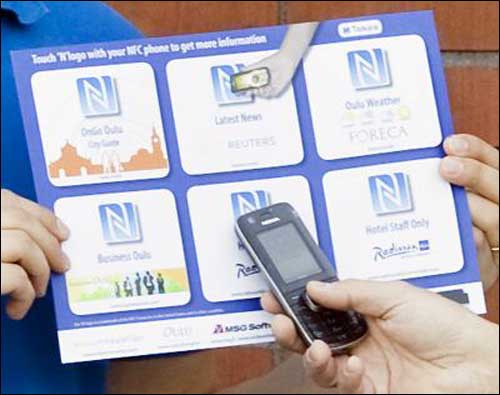Finnish printing products and services company Hansaprint and RFID tag manufacturer UPM Raflatac have teamed up to establish TagAge, a Web portal that provides printed paper or plastic labels, stickers, cards, hangtags and posters with embedded Near Field Communication (NFC) tags to customers worldwide, through online orders. The new Web portal, launched on Sept. 3, allows a user to order thousands of printed NFC-enabled items, or just a few, customized the way that buyer sees fit.
The system is intended to meet a growing demand for media containing embedded NFC tags that Hansaprint’s management predicts will correspond with sales of NFC-enabled mobile phones to consumers in the coming years. As NFC-enabled phones are predicted to be manufactured more commonly worldwide in the next few years, says Hansaprint’s development manager, Tommi Katila, there are currently very few options available for those who might want to use their phones as NFC readers by purchasing a few NFC-integrated printed products.
Hansaprint decided to introduce the idea of a Web portal for smaller, customized orders of NFC-integrated printed products during a 2008 NFC Forum competition—an annual event hosted by the organization to promote the development and deployment of innovative NFC services. The idea was selected by the NFC Forum to be presented that year, Katila says, and was ultimately awarded second place in the competition. Based on the interest generated from that presentation, the company then approached UPM Raflatac early in 2009, and the two firms formed a partnership that led to the creation of TagAge.
Glued to the back of each NFC-integrated printed item is a UPM Raflatac passive 13.56 MHz RFID inlay that complies with the ISO 14443A standard, as well as NFC standards. (Although the portal is currently set up only for NFC tags, TagAge can also provide printed items with embedded UHF EPC Gen 2 tags, upon request.)
With the portal, customers can order posters, business cards, labels, hangtags, disposable tickets, windshield stickers or conference badges, as well as other options. All of the items are plastic, with the exception of posters, which are made of paper but are coated with a protective layer to enhance their appearance and make them more suitable for outdoor use. The labels and smaller cards are available with an adhesive backing so they can be attached to various surfaces. The tags embedded in the adhesive cards and labels, however, will not function if applied to metal, says Jouko Aumasalo, UPM Raflatac’s business development director, though such a tag could be provided for a customized application.
A user creates his or her own print layout by first uploading a JPG, GIF or PSD image file. The user chooses either a 35-millimeter-wide (1.4-inch wide) circular BullsEye inlay (containing either a Mifare Ultralight chip with 512 bits, or a Mifare Standard chip with 1 kilobyte of read/write memory) or a 45-by-76-millimeter (1.8-by-3-inch) rectangular RaceTrack inlay (also available with either a Mifare Ultralight or Standard chip). The user indicates the tag’s position (known as the NFC-enabled hotspot) in his or her requested smart product, then inputs the information that should be encoded to the tag (a URL or phone number, for instance).
The system automatically calculates the amount of memory the chip will require for the data requested by the user. The buyer receives a price—which, for simple orders, typically ranges from €1 ($1.45) apiece for an order of 1,000 or more, to €2 ($3) each for a smaller order—and places the order. TagAge prints the cards, posters or labels with an encoded UPM Raflatac NFC tag, then ships them to customers in most parts of the world within a few days, or up to two weeks. If buyers have trouble with their orders, they can e-mail TagAge and speak with a consultant.
Thus far, Hansaprint and UPM Raflatac are selling NFC-enabled printed items to business customers in Finland and other parts of Europe, but they have not generated new online TagAge customers since launching the portal last week. Katila predicts that most of TagAge’s customers will be in the businesses-to-business model (for instance, companies that sell RFID solutions to other businesses), as their current customers are. One such customer is Finnish RFID solutions provider LogiNets.
With the introduction of NFC phones on the market, Hansaprint expects a broad range of consumers could also begin signing into the portal to order tags for their own purposes. “It’s a classic chicken-and-egg thing,” Katila states. NFC-enabled phones have not been manufactured in wide numbers because the NFC applications are not yet there, while the applications have not gained momentum due to a lack of NFC-enabled phones. “We are going ahead and presenting the egg,” he says. “Now we are waiting for the chicken.”
At present, companies using TagAge products typically purchase tags for asset management, access control or employee tracking. One unnamed TagAge customer, for example, utilizes NFC tags and NFC-enabled mobile phones to manage the work of its staff members who clean commercial sites. When a worker arrives at a site, he or she taps a mobile phone against a tag on the wall, and that information is then transmitted to the company’s back-end system, indicating when and where that individual arrived. He or she can also receive instructions on the mobile phone at that time, if the specific customer had a specialized request, such as to clean a particular room.
Hansaprint and UPM Raflatac expect the portal’s usage to be slow at first. But with the onset of NFC-enabled phones in the market within the next few years, the companies predict business will increase quickly—in part, the partners indicate, because there are few other options for consumers who wish to use NFC-enabled labels for their own purposes.
“If you need a small number of NFC tags, it’s really difficult to find something like that,” Aumasalo says, noting that RFID tag manufacturers tend to offer RFID or NFC tags in quantities of tens of thousands or more. What’s more, Katila adds, the printing and encoding often need to be done separately at different sites, while TagAge can process an order quickly by printing, encoding and shipping the items at a single location.




